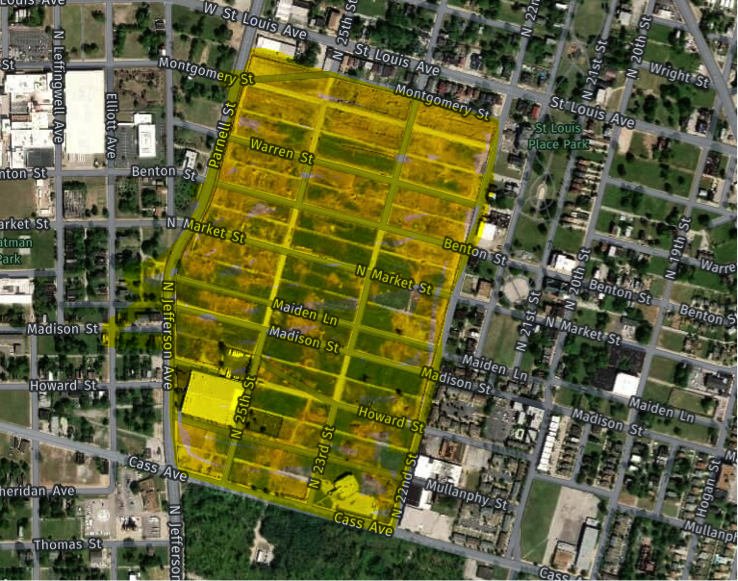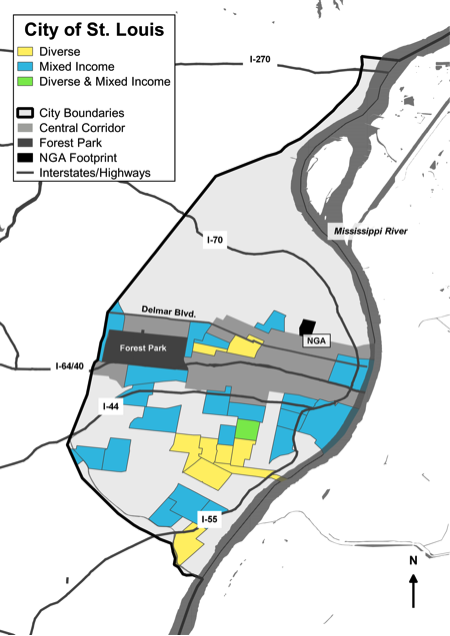Gentrification Debates Without Gentrification?
By Todd Swanstrom
Editor’s note: We’re pleased to offer a guest commentary from Todd Swanstrom. Todd is the Des Lee Professor of Community Collaboration and Public Policy Administration at the
University of Missouri – St. Louis. He is also co-author of Place Matters: Metropolitics for the Twenty-First Century (http://www.kansaspress.ku.edu/drepl3.html).
Recent research has provided evidence for the legend that Eskimos have more than fifty words for snow. Unfortunately, we seem to have only one word for economically improving neighborhoods: gentrification. Our profound lack of linguistic nuance is crippling our ability to talk about what kind of future we want to see for urban neighborhoods.
In the early 2000s, I taught courses in urban planning at Saint Louis University. The City of St. Louis is the #1 shrinking city in the world – having lost more than half a million people in the last half of the Twentieth Century (from 856,796 in 1950 to 348,189 in 2000). For the first time, however, I began to notice that a few neighborhoods were coming back and actually gaining population and investment. I would bring these up in class. Invariably, a student would chime in, “But professor, that’s gentrification!” – bursting my bubble.
I now have a position at the University of Missouri, St. Louis where I spend a great deal of my time working with a coalition of community development nonprofits. I continue to hear anxious cries of “gentrification!” This time, they are directed not at rebounding neighborhoods but at poor African American neighborhoods north of the infamous “Delmar Divide”.
Historically, the biggest divide in the St. Louis region has been east-west, between the central city and its suburbs – with communities becoming progressively wealthier and whiter as you move west out of downtown. Increasingly, however, the biggest divide in the region runs north and south. In the era of Jim Crow, a tangle of public laws and private practices confined African Americans to neighborhoods north of Delmar Boulevard (see map). To this day, the areas north of Delmar tend to be African American and lower income. This now includes North County suburbs like Ferguson. All of the neighborhoods identified as racially and ethnically diverse (yellow) or mixed income (blue) in City Observatory’s recent report on the subject are South of Delmar.
Despite a weak housing market, many activists have warned about gentrification around the new $1.75 billion National Geospatial Agency (NGA) headquarters that is under construction in North St. Louis. When completed it will employ over 3,000 highly skilled professionals with incomes averaging over $90,000 a year. Even though there is little evidence yet that NGA scientists will choose to live in the area, many people are warning about gentrification. In most of the neighborhoods around the new NGA headquarters, the housing market has collapsed. If you go to Zillow.com, you will find that there are almost no houses for sale in the immediate area around NGa and the few that are often sell for less than $50,000. If young professionals began moving in, there would be plenty of room for them in the vast tracts of vacant land around NGA (see Google Earth image of the area around NGA).

By contrast, the Central Corridor is booming with growth in medical, biotech, and various tech start-ups. My research on neighborhood change in St. Louis documents that there are, indeed, what I call “gentrification-like” processes going on. Young professionals who work in the Central Corridor are moving in to the Central Corridor and nearby neighborhoods to the south.
This trend, however, does not fit the classic definition of gentrification — understood as high-income households moving into poor, minority neighborhoods and rapidly displacing long-time residents. First, the neighborhood undergoing “gentrification-like” processes are not poor minority neighborhoods. Gentrification is almost completely absent north of Delmar. “Gentrification-like processes” are concentrated on neighborhoods in and just south of the Central Corridor that have always done relatively well.
Second, there is little evidence that “gentrification” is creating economic pressures that are rapidly pushing out large numbers of low-income residents. Indeed, our data shows that if you take out the citywide increases in rents, the rent burden actually fell in many of the “gentrifying” neighborhoods between 2000 and 2016. In 2016, the median rent in these communities was generally affordable to households making considerably less than the median income for the metropolitan area.
These neighborhoods have not become enclaves of rich white people. As the map shows, many of the most racially and economically diverse neighborhoods in the city are “gentrifying” neighborhoods in or just south of the Central Corridor. Indeed, according to a recent City Observatory report, the only census tract in the entire region that is both economically and racially diverse is Tower Grove East (seen in green on the map), a neighborhood just east of Grand Avenue that has witnessed an influx of young professionals.
Clearly, if I presented these findings to the activists in St. Louis who warn about gentrification, it would have absolutely no effect – and for good reason. Those who are worked up about gentrification in St. Louis don’t have some kind of conceptual or empirical confusion that social science research needs to straighten out. People are worried about gentrification for a reason. It is based on their lived experience.
In effect, “gentrification” has become the “g-word”–a kind of default term to express people’s anxieties about powerlessness and widening economic and spatial inequalities. Affordable housing is an issue in St. Louis, but the cause is not so much gentrification as stagnating wages and a private rental market that is not capable of providing decent housing for those at the bottom of the income scale. This is true everywhere – not just in St. Louis.
The forces behind these growing rifts are mostly impersonal and invisible, but neighborhood change, when it happens, is not. Not surprisingly, people focus on the things that they can see with their own eyes. Like many places, St. Louis is becoming a more divided city. Wages are stagnating and rents are rising across the region. Between 2000 and 2016, the median income of renters in St. Louis fell by more than 8 percent after controlling for inflation. The median income of homeowners rose slightly. (Calculated by Alan Mallach using data from U.S. Census, 1999 income, and American Community Survey data, 2012-2016). The Central Corridor is booming while the North Side continues to decline. People project these broader processes of division onto specific neighborhoods.
For the black community, concerns about displacement have a real basis in history. In the 1950s and 1960s, urban renewal and highway building forcibly displaced tens of thousands of African Americans. “Gentrification” is a shout out by people who feel they have little control over their lives and their neighborhoods.
Research shows that in cities across the nation, many more people live in neighborhoods that are going from low poverty to high poverty than from high poverty to low poverty (what we normally think of as gentrification). Especially in older industrial cities like St. Louis, the most pressing problem is not that higher income households are moving toward the poor and pushing them out – but that they continue to move away from the poor, leaving behind communities bereft of opportunities and resources.
We need a more nuanced vocabulary to discuss economically ascending neighborhoods. Right now, we have many neighborhoods experiencing “gentrification-like processes” but not exhibiting the massive displacement pressures roiling cities like Seattle, San Francisco, and New York. In St. Louis, over 90 percent of those who work in the Central Corridor live outside the Central Corridor. I wish many more of them lived in the Central Corridor or in other city neighborhoods. Of course, at some point in the future, this could happen and rents would then rise exponentially causing massive displacement. For this reason, we should act now, while land prices are still low, to preserve an adequate supply of affordable housing through land trusts, nonprofit-owned housing, and other methods.
Today, however, the big disruptive challenge facing older industrial cities like St. Louis is not gentrification but depopulation and disinvestment – not re-urbanization but de-urbanization. Contagious abandonment and the decline of solid working and middle-class neighborhoods are the most pressing issues facing St. Louis – not gentrification. At the same time, we cannot dismiss fears of gentrification. Ultimately, the only way to dispel those fears is to help city residents acquire political power, access to jobs in the new economy, and control over their own communities.
Editor’s note: This post has been revised to correct a reference to the home locations of those who work in the Central Corridor. (August 16).


